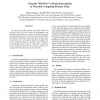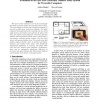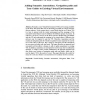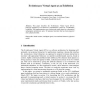102
click to vote
ISWC
2006
IEEE
15 years 6 months ago
2006
IEEE
Activity Recognition has gained a lot of interest in recent years due to its potential and usefulness for context-aware wearable computing. However, most approaches for activity r...
ISWC
2006
IEEE
15 years 6 months ago
2006
IEEE
102
click to vote
ISWC
2006
IEEE
15 years 6 months ago
2006
IEEE
This paper describes a localization method with wearable electromagnetic sensor and orientation sensor for wearable computer users. Many user localization methods have been invest...
123
click to vote
ISWC
2006
IEEE
15 years 6 months ago
2006
IEEE
As users of wearable computers are often involved in real-world tasks of critical nature, the management and handling of interruptions is crucial for efficient interaction and ta...
ISWC
2006
IEEE
15 years 6 months ago
2006
IEEE
We are developing a modular electronic device to allow users to perceive and respond simultaneously to multiple spatial information sources using haptic stimulus. Each module of t...
ISWC
2006
IEEE
15 years 6 months ago
2006
IEEE
Construction kits have long been popular as educational artifacts, supporting and encouraging creative explorations of engineering and design; but to date, such kits have had litt...
84
Voted
ISWC
2006
IEEE
15 years 6 months ago
2006
IEEE
We report on the results of a user study to investigate the utility of passive haptics for eyes-free numeric entry. This work targets cursorless user interfaces designed for use w...
104
click to vote
VSMM
2007
Springer
15 years 6 months ago
2007
Springer
Nowadays, more Virtual Environments (VEs) are becoming available on the Web. This means that VEs are becoming accessible to a larger and more diverse audience. It also means that i...
VSMM
2007
Springer
15 years 6 months ago
2007
Springer
Prototypes for automated spatial layout in architecture focus on approaches, which define occupiable space as an orthogonal 2D-grid and use algorithms to allocate each rectangle o...
103
click to vote
VSMM
2007
Springer
15 years 6 months ago
2007
Springer
This paper describes the Evolutionary Virtual Agent (EVA) prototype designed as an interactive entertainment system for a multimedia exhibition. This implementation uses a behavior...




